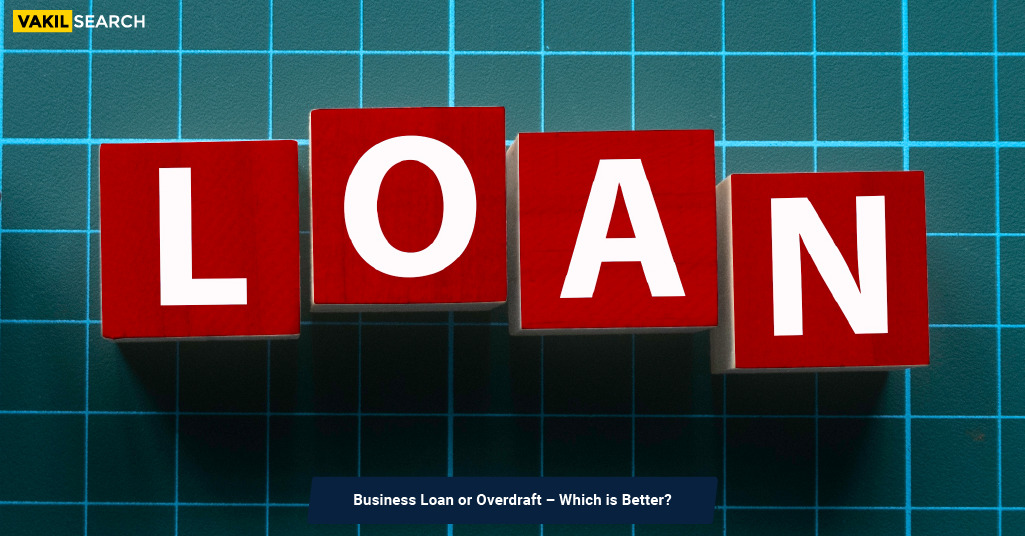Discover how Vakilsearch Business Loans can cater to your specific business needs. This article provides an in-depth comparison of business loans and overdrafts, explaining their features and benefits with the use of practical examples.
Introduction
When it comes to managing your business’s financial needs, two borrowing options stand out: business loans and overdrafts. Each has its own set of features and benefits, making them suitable for different situations.
In this article, we will compare business loans and overdrafts, highlighting their features, benefits, and ideal use cases. We’ll also provide practical examples and tips to help you decide which option is better suited for your specific business needs.
Comparing Business Loans and Overdrafts
Let’s dive into the features and benefits of both business loans and overdrafts to understand when each option shines.
Business Loans
Business loans disburse a lump sum amount that can be used for various purposes, such as expansion, working capital, or equipment purchases. These loans typically come with fixed interest rates, allowing for predictable monthly payments.
Moreover, business loans require regular monthly repayments over a fixed tenure. Depending on the type of business loan, collateral may be required, in the form of property or other assets. All in all business loans are suitable for long-term projects or substantial investments.
Simplify your business set up costs with our startup cost calculator. Get precise estimates for your new venture!
Overdrafts
Overdrafts provide a flexible credit line that allows you to withdraw funds as needed, up to a predetermined limit. In this facility, interest is charged only on the amount you use from the overdraft facility.
It is to be noted here that overdrafts do not have a fixed repayment schedule; this means you can repay the amount borrowed at your convenience. They are typically unsecured and, hence do not require pleading of assets. All in all overdraft facilities are ideal for covering short-term cash flow gaps or unexpected expenses.
When to Choose a Business Loan
Here are scenarios where opting for a business loan makes sense:
Long-term Horizon: If you’re planning a substantial long-term investment, such as expanding your business or acquiring expensive equipment, a business loan with its fixed terms and structured repayment may be the better choice.
One-time Predictable Expense: When you have clear-cut expenses and need a lump sum amount, a business loan can provide predictability in terms of interest rates and repayments.
Credibility and Credit Score Building: Consistent repayment of a business loan can help build your business credit profile, potentially enabling you to secure larger loans in the future.
When to Choose an Overdraft
Consider an overdraft in the following situations:
Short-term Cash Flow Needs: When you experience temporary cash flow challenges or need to cover immediate expenses, you can use an overdraft to access funds on an as-needed basis.
Recurring Expense Needs: If your funding needs recur in a cyclic nature, an overdraft facility can be a valuable tool to bridge gaps in working capital without adding to the burden of fixed monthly repayments.
Varying Cash-Flow Requirements: With an overdraft, you only pay interest on the amount you use, making it cost-effective when you have varying cash flow requirements.
Practical Examples
Scenario 1 – When is a Business Loan the Best Fit?
Suppose you run a manufacturing business and plan to purchase new machinery that costs ₹1 crore. You can opt for a business loan with a fixed interest rate and a 5-year repayment tenure. This will allow you to make monthly payments while ensuring a steady cash flow for your business.
Scenario 2 – When is a Overdraft Facility the Best Fit?
You own a retail store, and during the festive season, you experience a sudden surge in customer demand. To stock up on inventory, you can utilize an overdraft facility to access ₹20 lakhs. Since it’s a short-term need, you need only to pay interest on the amount used, and once the season ends, you can refund the overdraft account.
Tips for Choosing Between a Business Loan and an Overdraft
Assess Your Needs: Evaluate the nature and duration of your funding requirements. Determine whether you need a lump sum amount or a flexible credit line.
Consider Costs: Compare the interest rates and fees associated with business loans and overdrafts to understand the cost of debt implications.
Cash Flow Analysis: Analyze your business’s cash flow patterns to identify whether a structured repayment schedule aligns with your cash flow.
Risk Tolerance: Assess your risk tolerance. Keep in mind that with a business loan, you have a fixed obligation, whereas an overdraft provides more flexibility but can lead to higher costs if not managed wisely.
Benefits of Vakilsearch Business Loan
Vakilsearch Business Loan offers several benefits to cater to your specific business needs:
Customized Solutions: Vakilsearch understands that every business is unique, offering tailor-made loan options that align with your requirements.
Flexible Repayment: Vakilsearch offers flexible repayment options that cater to your business’s cash flow.
Expert Guidance: Benefit from expert guidance throughout the loan application process, ensuring you make informed decisions.
Conclusion
Choosing between a business loan and an overdraft requires a careful assessment of your business’s financial needs, cash flow patterns, and risk tolerance. Each option offers distinct features and benefits that can be advantageous in specific scenarios.
By considering your unique circumstances and following the tips provided, you can make an informed decision that aligns with your business’s financial goals. Our experts are here to assist you in finding the right financing solution tailored to your needs. Reach out to us today!
Also, Read:




